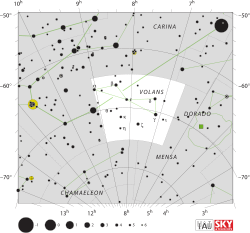Epsilon Volantis
Epsilon Volantis (ε Vol, ε Volantis) is a quadruple star system[4] in the southern constellation Volans. This star is at the center of the constellation of Volans and connects the "wings" of the constellation. Based upon parallax measurements, is roughly 560 light years from Earth.
 | |
| Observation data Epoch J2000.0 Equinox J2000.0 | |
|---|---|
| Constellation | Volans |
| Right ascension | 08h 07m 55.79420s[1] |
| Declination | −68° 37′ 01.4350″[1] |
| Apparent magnitude (V) | +4.33[2] |
| Characteristics | |
| Spectral type | B5 III[3] (B6 IV + B8 + A2 V + A2 V)[4] |
| B−V color index | −0.12[2] |
| Astrometry | |
| Radial velocity (Rv) | +9.6[5] km/s |
| Proper motion (μ) | RA: −29.14[1] mas/yr Dec.: +29.26[1] mas/yr |
| Parallax (π) | 5.80 ± 0.39[1] mas |
| Distance | 560 ± 40 ly (170 ± 10 pc) |
| Absolute magnitude (MV) | −1.82[6] |
| Other designations | |
| Database references | |
| SIMBAD | data |
The primary component, Epsilon Volantis A, is a spectroscopic binary.[8] It is classified a blue-white B-type giant star and has an apparent magnitude of +4.35. (The individual components are classified as B6IV and B8.)[4] The binary system has an orbital period of 14.1683 days. The binary's companion, Epsilon Volantis B, is 6.05 arcseconds away and has an apparent magnitude of +8.1. It too is a spectroscopic binary, consisting of two A-type main sequence stars with stellar classifications of A2 V and an orbital period of "a few days".[4]
References
- van Leeuwen, F. (2007), "Validation of the new Hipparcos reduction", Astronomy and Astrophysics, 474 (2): 653–664, arXiv:0708.1752, Bibcode:2007A&A...474..653V, doi:10.1051/0004-6361:20078357.
- Cousins, A. W. J. (1977), "UCBV Magnitudes and Colours of South Circumpolar Stars", South African Astronomical Observatory Circulars, 1: 51, Bibcode:1977SAAOC...1...51C.
- Houk, N.; Cowley, A. P. (1975), University of Michigan Catalogue of two-dimensional spectral types for the HD stars, 1, Bibcode:1975mcts.book.....H.
- Veramendi, M. E.; González, J. F. (July 2014), "Spectroscopic study of early-type multiple stellar systems. II. New binary subsystems", Astronomy & Astrophysics, 567: 10, arXiv:1405.1084, Bibcode:2014A&A...567A..35V, doi:10.1051/0004-6361/201423736, A35.
- Wilson, Ralph Elmer (1953), General catalogue of stellar radial velocities, Carnegie Institution of Washington, Bibcode:1953GCRV..C......0W.
- Anderson, E.; Francis, Ch. (2012), "XHIP: An extended hipparcos compilation", Astronomy Letters, 38 (5): 331, arXiv:1108.4971, Bibcode:2012AstL...38..331A, doi:10.1134/S1063773712050015.
- "eps Vol". SIMBAD. Centre de données astronomiques de Strasbourg. Retrieved 2016-09-02.
- Medici, A.; Hubrig, S. (January 2000), "Triple System epsilon Vol and Quadruple System eta Mus: the Mass Ratio in Close Binary Systems", Information Bulletin on Variable Stars (4827): 1, Bibcode:2000IBVS.4827....1M.